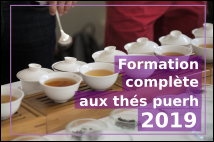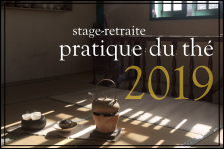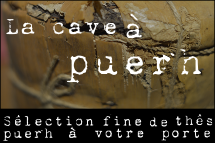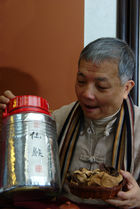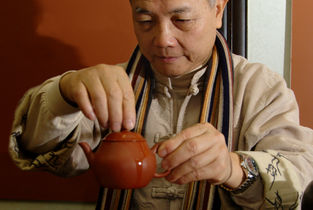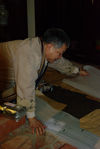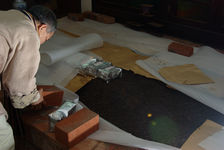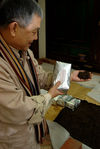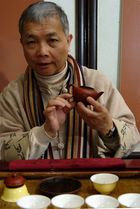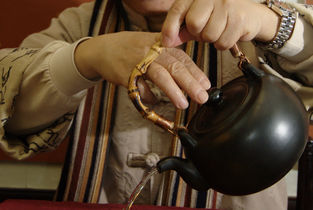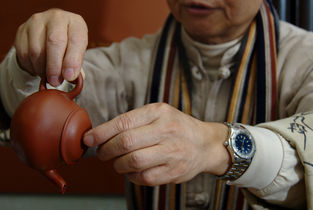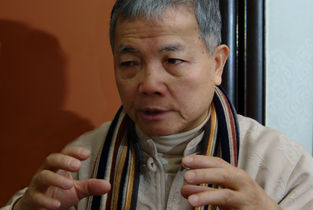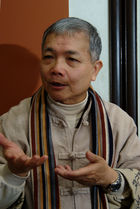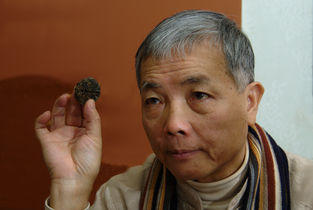 This page is not a real translation but just an automatic translation generated by computer of the original article, written in French language! Its not good... but better than nothing!
This page is not a real translation but just an automatic translation generated by computer of the original article, written in French language! Its not good... but better than nothing!Want to help us do diffuse puerh tea culture in english, by providing a better (or corrected) translation?
Please contact us!

Vesper Chan, or 陈国义 (Chen Guo Yi) in Chinese, is one of the greatest figures of tea and puerh. Founder of the famous "Best Tea House" in Hong Kong (see article "The best tea houses in Hong Kong"), Vesper Chan is recognized as one of the world's leading specialists of tea, especially puerh (Pu Er tea) and wulong, but also as One of the most renowned experts in storage and aging of these teas. Often considered the inventor of dry storage is assigned to particular Vesper Chan's arrival on the market and popularization of puerh (Pu Er tea) raw (green) in Hong Kong in the 90s, where only consumed while puerh (Pu Er tea) fermented (by wu dui Hong Kong or wet storage).
Vesper Chan is also particularly known to fans and collectors for a famous cake named Bing Qing 88 , a stock of 7542 produced by Menghai Tea Factory between 1989 and 1991, and kept with great care by Vesper Chan. This cake, made history puerh (Pu Er tea) tea, is highly sought by collectors and enthusiasts puerh (Pu Er tea) old and routinely sell at auction for several thousand euros each.
I had the chance to talk at length with Vesper Chan in Hong Kong last winter, and it is a pleasure to deliver, through this article, most of this interview, which traces with high sensitivity and humility, almost 30 years of life and history of this great "master" Hong Kong Chinese tea.
A big thank you again for giving us Vesper Chan spent as much time and energy.
Vesper by Vesper Chan Chan, the story of a great man of Chinese tea
I will simply tell you the story of my life. Before I am in the tea trade, there 23 years ago, I read a lot about tea, then I went to Taiwan and the Chinese tea mountains, to understand how was the tea, how was grown tea. And the first time I went to tea in the mountains, in 1996, it was a wonderful experience for me, because everything was cool, as the natural flavor that comes from the flowers ... and it makes you feel ... really different in a city that (laughs). So that's why I fell in love tea. It was the very beginning.
But even before that, ie there are roughly 30 years, I worked in the petrochemical industry, which allowed me to make lots of money. I worked in this field for 15 years, then I started to get a little bored and I wanted to visit the world. I decided to visit my customers and suppliers of petrochemical industry. They were in the U.S., Germany, England, Holland, Belgium, France. Countries well known for their advances in knowledge of the field of petrochemicals. But when I arrived in these countries, every time I found the same thing: a very heavy pollution. Above all, the sea, the sea at the approach of the cities was black! I was terrified. The worst was the sea in Japan and the Netherlands.
There's something very strange: on the one hand cities are so developed, everything is so convenient and modern, but when you get there by sea, a sea of black, waaaaaa, it gives you a picture radically different. And that's when I realized, why in the world there were people who fought to protect the environment. Why they are so outraged by this petroleum pollution in cities and why in their view it is this that ruin the planet. At that time, I understood their point of view.
Once back in Hong Kong, I felt so guilty, and I started thinking: what should I do? Since my business is ruining the planet, and makes the pollution worse. So I said I had to follow the right path. Everyone must take a step, even if it seems small, to protect our planet. It's a need. That's when I began a profound questions about what I should do after oil. I read so many books to find an answer that this research has started to become a real hobby.
Finally, I found that tea was something wonderful! First, because the tea does not pollute the cities, but tea also allows people to be healthier without the need to destroy anything or kill anyone. Because, if for example you want to become a good cop, you will have to kill people (laughs). So I said that tea could become a wonderful hobby for my retirement. It was about .... 28 years ago, the 23 years of my business, and the first 5 years I spent studying tea.
So I started by spending about five years doing research on tea, learn how to understand the Chinese tea, how to understand the country, I mean the land where these teas are grown. Then I spent the last two years studying how to brew tea. After spending the past two years on the art of making tea, everything became clear, and so I opened a small tea shop. This is the birth of the "Best Tea House" (laughs).
After opening my store of tea, so I thought I should write a book to teach people to understand the tea, how to prepare it, etc.. But I did not feel ready for it, so I planned to wait for 3 years before writing this book. And after these 3 years in the middle of tea, I realized that I was really a beginner, there were so many things that continued to escape me, I did not understand ... and so I decided not to start my book (laughs). Then I thought: Ok, Vesper, I give you two more years, it will make a total of 5 years .... Two years have passed so, then I realized that if the tea was a house I had just set foot in the first ... and so I again decided not to write this book. So I gave myself another 5 years older, what will 10 years. And after these 10 years, I finally had the courage to write this book, but it was when my business exploded, it worked too well. I opened new branches here and there, one or two each year. So finally I had no time to write this book.
At that time, a radio station asked me to intervene on their antenna about tea. They offered to do a series of 26 programs on the different types of tea. So for each tea, I did something really simple for beginners. Because the number of radio listeners did not understand the tea. Therefore, I did something very simple, useful. Then the radio has collected all the information to make this little book (laughs). Finally I had my book. I have reviewed the green tea, tea-old, flavored tea, the tea and wulong puerh, because the series covered mainly the six major types of Mainland China and the Taiwan: the wulong. Among the specialty teas covered in this book there is also the wulong old, and, less common still, we have another wonderful tea ... I'll show you.
They are aged orange peel. These are not ordinary oranges, but a particular variety of oranges whose skin is very thin. These oranges then you should store at least 5-8 years before using the bark. Then they will give you a wonderful aroma. Feel the ... Moreover, they contain various beneficial components used in Chinese medicine. When people reach fifty years, their respiratory system is not as powerful as most when they were young. But when you combine these orange peel tea, they will make your throat very clean, more efficient and smooth all your respiratory system. This tea, I'll tell you, was stored with this type of orange peel elderly since 1995. This is one of my special knowledge, I also mentioned in the book, and it's a gift for you.
Let me brew this tea for you to taste. As you see, this type of oranges elderly has been in contact with the tea. There is a layer of tea leaves about 2 inches thick, then a layer of orange peel, then 2 inches of tea and then a layer of orange peel, then a layer two inches, etc.. This can be done with wulong and puerh. But with this variety of orange peel, even if they are aged 10 years, they can be assembled with young or young puerh (Pu Er tea) wulong. Because, you know, the green is quite puerh (Pu Er tea) ... Spicy ... and therefore, we must first wait that aroma of green evaporates.
You need this kind of knowledge, otherwise you can not do this kind of tea. This is the same for wulong, you can not use wulong intense aromas and fresh, otherwise they go wrong, would deteriorate. We must first put them on fire, leave all the green to evaporate, and only after you can mix them with orange peel, then let 23, 30, 50. More time is long the result will be more beautiful and enjoyable. So for this type of tea, it takes at least let the tea and bark together for 10 years, but they are allowed, the better (laughs).
Yes. Good question. After starting my business, during the second year, I had a client who was a Chinese doctor. He loved the tea puerh, especially puerh (Pu Er tea) old. One day he asked me, Mr. Chan, why is it that you would not put some orange peels in your old age puerh? So I asked him why, because I had never heard of. He then talked about what he had learned from his father, who was a renowned Chinese doctor. Notably, these seniors were very good bark to centralize the effect of Chinese medicine. In addition they allowed to protect the stomach. For tea can worsen the effects of a stomach slightly shabby. In this sense, these associate with puerh (Pu Er tea) old bark protects the stomach and thus the health of the drinker.
So when he told me this, I tried to assemble tea puerh (Pu Er tea) to orange peel aged 10 years, and I waited about 3 years. At this point, I had not talked to my students and clients. One day I brewed various teas that I gave a taste of those who were there. I discovered that the cups which were finished as soon as those containing tea was that had been aged with orange peel (laughs). All finished! Of course, they did not know what it was. So I thought it was probably a good thing for me to start doing this type of tea, really wonderful for connoisseurs.
This is a tea-tie guan yin deeply fermented, which has grown old with this variety of orange peel elderly. Many of my students want to learn how to make this tea, or else, they buy to age it. I know a couple who have a stock of these jars home, sometimes more than 30 jars, and it's very perceptive, because later it will be even better.
There are two areas in which I pointed tea: tea and tea wulong puerh. I will first tell you how I understand the wulong, okay?
Some people, perhaps not educated enough, you will probably say simply that there are three types of fermentation wulong: light, medium and high. Therefore, fermentation provides a slight aroma very natural, green. Fermentations require stronger, in turn, over time, and allow the tea to age. But why must roast the leaves longer. Normally, for teas that are found on the market, we leave the leaves on the fire for two hours. We will then use an intense fire, and this makes the leaves very dark.
However these are not real good teas, they are products for the market. The real good teas require a deep fermentation, about 30%, where a slight fermentation is between 10% and 15%. So, for this type of deep fermentation, it is necessary to roast tea between 20 and 30 hours, followed by refining of about three months, and only then you can put on the market. These are the normal steps to make a fermented quality wulong deeply. But today, there are not many people who have the desire to do this type of tea, because it requires time, energy, labor, and then, you must up prices. But the consumer does not understand why the price is so high. So it's not easy. Therefore, we only sell this type of tea connoisseurs (laughs). Forming a group of experts for this kind of wulong. Part of this type of amateurs comes from Taiwan, the other from China, primarily in Hong Kong.
This type of quality wulong can be stored for many years. Few people understand, they think only puerh (Pu Er tea) can age, but is another wonderful wulong tea, which allows the connoisseur to savor the emergence of wonderful aromas, mouth and mind. Everyone knows that wulong comes from Taiwan, Wu Yi Mountain, Anxi and Guangong, Dan Cong. But each of these regions produces different tastes. The wulong Dan Cong were so active flavors, fruity and sweet, those of Wu Yi mountains are so heavy, strong, while those from Taiwan are very silky and fresh. So if you know how to appreciate these different types of wulong ... How wonderful life!
Here, in brief my view of wulong. I then recognized and passionate about tea puerh. This is mainly because of a very famous tea called and known 88 qing (ba ba qing) . Because this tea in my store came about ... 5 years after I started my business. The seller was the representative of Menghai Tea Factory. He brought me this cake puerh, and when I opened the package and that I looked at the cake ... I was scared! Why puerh (Pu Er tea) had it a green color? Is this really was the puerh? I wanted to know (the puerh (Pu Er tea) was then consumed in Hong Kong in the form of fermented or from wet storage, so dark - ed.). And then he said yes, it's real tea puerh, but it is generally not sold on the market. They had much in stock at Menghai Tea Factory, so I asked him why no one has purchased this tea before? I have never tasted such tea puerh! He explained that this was an unfermented tea (gross).
After tasting, I discovered that this tea had a really natural flavor, aroma of the mountain. Then I brewed this tea 7, 8, 9 times ... without the taste of tea is lost. In Hong Kong we typically consumed puerh (Pu Er tea) artificially fermented (cha shu). When you get four or five infusions, it becomes liquid, it is not really tea. But there, up to ten infusions, I really thought it was incredible. Then I asked the price. The price was then 7.8 RMB () per wafer. At that time, when I importais 500g long jing already it cost 380 RMB (). But puerh (Pu Er tea) green, you can brew two or three times more than a long jing. Why is it so cheap? I really did not believe this price!
He said: Mr Chan, if you want to buy, there are more than 90 tons. I asked her what volume represented a ton? (Broad laughs). I had no idea! And therefore, it was 30 tons to about 2 times the size of my little shop. I thought woooooow, how long will it take me to sell the sale of all that tea? But it was so cheap, I did not give up. So I asked: can we make an arrangement, I need you to deliver the tea three times over three years, so I have three years to try to educate my clients, trying to find how to sell such a tea. And he agreed to deliver over three years. Ok, but then I started to get really confused and scared: what to do with all that tea? I stored the tea for 5 years, I had no warehouse, so I rented a space in a public warehouse. One day, my accountant told me about the cost of storing this tea! This amounted to more than 300 000 HKD. You never understand, because they tell you about 5000 HKD per month, only 5000 HKD, it seems nothing. But time passes and you do not realize that the note is growing and what it costs in total, finally, more than 300 000 HKD for tea! I was scared (broad laughs)! With all that this tea had cost me eventually, I needed to double the price, then quickly to double again!
Ouuuuuuuulalala (laughs). But the toughest period was then, during the SARS epidemic.
Yes, it's true. So what could I do? I started the thing to send young. Because older consumers, did not think it was tea puerh! They have the habit of drinking puerh (Pu Er tea) very dark (or fermented from wet storage - ed.). We laughed on my back, I was called stupid: why is it that I was selling puerh (Pu Er tea) green? Many said that nobody would buy this tea! (Laughs). Yes, at that time, it was like that.
I imported this tea in 1993, with regular annual delivery between 1993 and 1995, and 1995, I had the whole delivery. Then I had to educate my clients, youth and students, to drink this tea. I had to learn to brew this tea, because, here, generally for puerh (Pu Er tea) (fermented - editor's note.), We washed the tea once, and then began the second infusion of at least 5 minutes. So I discovered that for this tea (not fermented - editor's note.), They must begin to infuse for 5 seconds. It was really the first concept, how to brew the puerh, not only in Hong Kong, but throughout China: using a special technique for brewing tea puerh, in just seconds. The students themselves, know this, but few understand it.
The first time, in a book I wrote to teach people how to brew tea in just seconds, and this message came on the market, few people from the tea took me for a fool: how Tea can give its flavor in just seconds? Now you can see what happens, not even in 5 seconds (he hands me a cup of tea in 2008 (Qing Feng)).
Then in 1997 it was time to Hong Kong where we learn that the island would become Chinese. So, many Hong Kong Chinese have immigrated to other countries: New Zealand, England, the United States and Canada. Before immigrating there, many people came to learn how to brew tea Chinese. So my tea house was full every night (for courses that give Vesper Chan daily - editor's note.)! There were over 40 people, we did not even have enough chairs for everyone to study and they remained standing (laughs). Yes! it was very active before 1997! They also liked to buy some good tea, and take them with them in these new countries. To have something to remember.
So at that time, many of my students bought a lot of qing 88 and took them with them in these countries. But after five years, in 2003 there was the SARS epidemic. It was the worst period, I was almost ruined. Almost ruined, because in one month, the first month after we started talking about SARS, nobody wanted to buy anything. And it was like that for a year! Only one or two people came into my shop to buy tea. So I ran in the tourist area, where I had seen a few empty shops in high traffic areas, and I had to pay 500 000 HKD per year for rent. Before the end of SARS in 2004 I had to mortgage my house, my two houses, in order to pay the wages of my employees. And myself, for 6 months I have not been able to afford. And with that, I still had to pay my debts, 3,000,000 HKD ... that's why I was almost ruined and I just asked: Why? I'm so sincere about quality tea (laughs) and I work so much! Even after business hours, at 7 pm, I start my classes for my students, up to 10 hours, sometimes until 11 o'clock, because I am so happy to teach. This for almost 10 years, and now I find myself really seriously in debt, without money or prospects ... So it was really become a business death (giggles)!
But after 2004, one day, I received a phone call and someone asks me, Mr Chan, I know you have a very good tea puerh, you name qing 88 . Can you sell me? Then I asked how he wanted? And he answered: how many did you? (Hearty laugh). Waoooo. I told him the price, only 150 HKD per wafer, but at that time in 2005, prices had mounted a lot and it was already worth 580 HKD per wafer. But I wanted to sell a lot, quickly collect a lot of money to pay my debts. So, I said only 150 HKD per wafer. Finally, he bought about 50 pancakes. But the following week, I get a new phone call from a woman: Mr. Chan, I know you have the qing 88 , I want to buy! And then I sold at 200 HKD. And after, a third person also called me again I've sold 200 HKD cake. But shortly after, the first buyer reminded me to buy more and then I switched to 250 HKD, and then he stopped buying. Then, a Taiwanese began to buy me. So in a month, I sold more than 3 000 0000 88 HKD qing , 3 million! Which was just enough to pay all my debts! Waaaahou, I was so happy! It was the happiest month of my life! Wonderful time ...
The 88 qing really brought me a profound experience on puerh. Why? I think I used my heart to store the tea in a dry storage. I did not follow those who sprinkle their tea water to make them age faster. And therefore, in this most difficult time, the qing 88 saved my life! It's the truth! Since that experience, I am increasingly feeling my puerh (Pu Er tea) to store the right way.
I'll let you taste a rare tea. This tea, I'll tell you, I have stored since 1996 ... my first tea. I think you are very lucky. It took so long to this tea to become what it is now, and you from day one, you can taste it (laughs).
In China, it insists that the water must be totally hot for brewing puerh. I am not quite agree, as you can see, I let down a little temperature before brewing the tea. Feel the emotion that emanates from the result. Not bad? Too hot water would have destroyed the emotion of tea, would have done something very hard. People who infuse the tea often do not understand the true function of temperature.
For me, this tea, when I close my eyes, this is a complete image of the mountain looming in my mind, farmers who live in wooden houses in the heart of an isolated area.
Also to infuse teas older, you should use a good teapot, teapot old. The teapot that I'm used to brew this tea has over 200 years, and predates the Chinese revolution. This is the ancient land of purple (Yixing). It makes all the difference. The main change is the form of water. The shape of the water is soft and round. Other teapots produce a more solid form of water, drier.
Indeed, it's the same thing, but it is also totally different. Because the puerh, tea must remain in contact with air, it is very important. For wulong the contrary, the tea should be closed completely. They are totally different concepts.
for dry storage ... why do I put the 88 qing in a dry storage? Because at the very beginning, before I started this business, I wanted to learn more about tea and wulong puerh. How do we roasted the wulong? How do we store the puerh? Why has puerh-there a color as dark? How it happened? What is the actual age of puerh (Pu Er tea) dark? Etc ... So I visited those producing tea puerh (Pu Er tea) in Hong Kong. In Hong Kong, they are not farmers, they do not grow trees, do not pick the leaves, what they do, it's just fermenting tea puerh (Pu Er tea) artificially. So I visited three of these storage "traditional" Hong Kong.
In the first, from a former, tea puerh (Pu Er tea) was put in a brick building. The building was open to the outside and any sunlight through it, is starting to descend to the west. The building was packed with piles of puerh. It was good people, because tea coming out of this storage was not completely black, but just slightly darker. I noticed, when visiting the building, the surface of the brick walls was completely wet, but they did not put water in the tea, they put the water outside the building, on the whole thereof. This is one of several fermentation processes that I saw.
One of the two other stocks that I visited, was owned by two former. The building was closed by doors completely airtight plastic: they opened for me, it was completely dark inside. When they opened the doors, a very strong smell really disgusting and immediately came to assault me. I put my head to see waaaaaaaaaaaaaaa then, oh my god, it was so disgusting! I was really questioned. Why Tea puerh (Pu Er tea) should be stored under these conditions? I did not even wanted to try this tea ... because ... it was like entering sewers of the city.
The following storage was located next to a landfill, a kind of waste treatment center. In this discharge, all sprinkled with white powder to prevent the development of germs. It produced a very intense and unpleasant odor. I fainted again. How have they been able to choose such a location for storage? I really do not understand why.
I saw another, run by a young. He used the barrels as the barrels of oil, maybe five barrels full of water, and showers. The puerh (Pu Er tea) lay like that, a stack next to each other. Of each shower at regular intervals, pssshit and pssshit, they spray water (broad laughs). This is the last store I saw Hong Kong. Maybe it is it better because at least he did not relieve repulsive flavor (laughter).
But all had something artificial. I tasted the tea that came out: there is no flavor was fresh, no. That's why I loved the 88 qing the first time I drank it. Something so natural, like the mountains, the aroma of green ... Wonderful! At that time I was strong, I swam in the winter, I climbed into the mountains, I plunged into the sea, I was fishing and the fish tasted fresh taste to see that they had (laughs). Threw very sensitive nature. That is why, when I collected the 88 qing , which were only 7542, I realized I really did not like how these people stored the puerh, and I put the tea in a public warehouse.
One thing also, at that time, it was before the SARS epidemic a few years before. I was not worried at all financial matters. I had amassed a lot of money with oil and I did not need to sell quickly this tea. It is also one of the reason why: I had enough money to live, and to do what I thought so. I'm so sincere about the quality and flavor, I did not want to ruin the qing 88 , so I put it in a clean storage. At this point, I had also no idea or desire to see that this tea would give 10 or 20 years, I just put in a clean, dry warehouse, to store it. Simply.
About 5 years later. He was very raw, very powerful. But the taste was not greatly changed, just the green was darker. That's why I wrote a poem about my experience of 88 qing is in this book. It became a famous poem.
Why I gave that name to this tea, qing 88 ? Because the sales manager told me that tea was stored at Menghai Tea Factory for several years. Nobody bought it because it was green. So, after buying this tea I thought Hong Kong each store sells only a single "brand" puerh (Pu Er tea) "Beeng Tse Qi". All these cakes are alike, regardless of the plant from which they come. Menghai, Xiaguan, in the end, these are all the same. So I said I could not do like them (laughs). I had to put a name on this single slab (due to its storage-ed). Another thing too, I created my company in 1988, and I considered what I was told to Menghai Tea Factory that these cakes were already a few years in 1993. So, going back a few years, it could be 1988. And so I chose 88 in memory of the opening year of my tea shop. That's why I called this cake "qing 88 " ("qing" meaning of it "green" in the sense of "raw"-ed.)
Second, if you say "88" in Cantonese ("baba"), this means that you will be a successful person. It's really a good meaning! Basics, the first "ba" means that you'll be a rich man, the second "ba" means ... you'll be even richer (laughter). Forecast wonderful!
When in 7542 Menghai Tea Factory the idea comes from 1975, because after Brands Red it was the first time they assemblairent teas of different types or from different mountains. And he gave this tea Reference 7572. The first 75 to 1975, the year of the design of this tea. Then comes the 4 which refers to the grade of tea, and finally the two to mean the plant from which this disc: "Menghai Tea Factory". And at that time, the tea was really good, despite the fact that it came from di tai (shrubs growing - ed.). The environment was better in those days, no pollution, no chemical fertilizers to make the trees greener, the biggest (and widely disputed facts questionable - ed.) At that time, in the mountains, tea grew naturally. And so were of high quality with tai di. Because to find tai di high quality you need to find high mountains, sometimes it's called green tea (Cha Tai Shen), it is much better (than tai di lowland).
The second part of the story (of 88 qing ) started about 2 years ago. The value of this tea cake has reached 15 000 HKD. Today it is more than 20 000 HKD cake. But already there are two different years, I discovered that my stock was exhausted! More than 88 qing . What should I do now? So I started working on the continuation of qing 88 , but with ancient trees. The quality will be better and although the 88 qing . Because qing 88 was Menghai Tea Factory, it was tai di, yes. But this time, because now we have a thorough knowledge of tea puerh, we must find an excellent quality, much better even than the 88 qing .
That's why I went to the tree of 3200 years, have you heard of this tree? (Tea tree famous monuments located Fengqing, Lincang, recognized as the oldest tea plant from China). I went to see this tree in 2002, and I had the right to sell tea tree for 5 years. I had this right hand, to exploit the "King of Tea" as it is called, the true 3200 years old. Because at that time, few people understand this tea. So I saw this tree and I spoke with one who was responsible. First, he visited me in Hong Kong and gave me a cake produced from the leaves of this tree. At this point, I have not paid attention to as the pancake. But the following year, when I opened the packaging of the cake ... the color had changed! It was no longer the fresh green of a leaf, but a deep and dark green. I had the experience of 88 qing , which would have had needed at least five years to achieve this color. This really surprised me. So I brewed a few leaves, and I found the wonderful tea. So I asked the person who gave me this tea for more information. That's when I learned that this was the only tea tree (tea) in China to have this age. And then I asked to come and see this tree. So we were already related before I saw the tree, he came to see me in Hong Kong, and gave me this tea.
I was so interested in this tree, I asked if it was possible to buy tea. I was told yes. So I said I did not want to just buy some cakes, but the entire production of the tree. Can you give me the right (exclusive) to use the tree for 10 years? The manager told me that yes, but he could not put it on paper, because he did not have permission to do that, he could just give me his word.
In the end I was not able to exploit it for 10 years, but I still able to enjoy it between 2002 and 2006. Because, from 2007, this tree was sold to another company, which bought 70% of the company that originally owned the tree. And I have not been allowed to buy the products. So the first year, have been produced only 3 boxes of this tea, Chenzhen sent to an auction. The auction reached 400 000 HKD per wafer ... So many wonderful stories of tea in my life (laughs)!
To understand this we must understand the theory of production. All the quality is focused on the first leaves of spring, like the first series of 7811 (famous pancake Feng Qing, see below - ed.) So if you want a high quality, it must both come from real trees, not shrubs, and other early spring crops. So when you store and sell this type of quality tea, you give a clear message to your customers: Where does this tea come from? How old is the tree? What is the harvest season? This is where we're focused.
But on the other side there are some people who have no need or desire to make a tea of such high quality. Because when you try to produce such high quality, this will result in high prices, and therefore it is not easy to stand up to competition. So what do they do? They take the second or third crop. And since consumers are not sharp enough and educated they do not realize it. There are even those who use tea fall. Or if you visit Yunnan and you observe the climate, you know the best time to harvest is before the beginning of May, mid-March to late April. After the rain comes and it will become more intense until August, before stopping. So after September, while the rain stopped, the sun returns, the trees of the mountain reborn and young buds emerge because they have had enough water. The buds and leaves that spring then are very large, wonderful! This is perfect for a beautiful cake to set before your eyes. But the taste is very bland. Because there is too much water in the soil. The farmer realized that few people want to buy this tea, so they lower their price in half, sometimes two-thirds to sell this tea. Superficial and producers, who's looking beyond the competition and are more focused on quantity than quality buy this tea. This is one reason why tea is assembled.
But you must understand that there is another approach to the assembly which is completely different. Since this cake has just five mountain tea. It has collected why teas from the first spring crops, but from five different mountains. This is the concept of the assembly who is behind the qingg 88 : They (Menghai Tea Factory) collected all the teas of different mountains, and have assembled to produce a quality tea. So it's a totally different approach. Different mountains in the fall would not have yielded the same result, this never could have had a flavor so rich, so good and such a balance in the mouth.
Ok What all tea lovers puerh (Pu Er tea) know is that in 2008 this market has collapsed. But in Hong Kong we have remained very stable. We have not been affected by this event. Why? Because we have educated people. We have learned to appreciate the quality tea. Especially for puerh (Pu Er tea) we have before tea from large trees s, located in the mountains, because they are more natural. With a tea that has grown without fertilizers, you can feel in your mouth sensations intensely natural. These teas are not strong, but provide high satisfaction throughout your body. So when people come to study and learn the puerh (Pu Er tea) in our teahouse, they can learn all about how to enjoy a good tea puerh, how to choose it. This puts us in a very safe, we are not affected (by the market crisis) and we continue to sell very high quality.
But, of course, we also understand that in China today, the market is huge. Last month, I visited some friends in China and I brewed the tea we are drinking (a famous tea ordered by Vesper Chan and produced from five mountains of Yunnan). They were not in the business of tea, just ordinary people. When I brewed this tea, 3 cups after they exclaimed they had never drunk tea as wonderful! Where is it? In what area? And then, each bought 30 flip-flops (210 wafers), immediately!
And today, this tea is already sold. A cake or two it is always possible, but not a thong or two, it's over.
what you saw in Hong Kong, you notice that (The Best Tea House) is more advanced on this subject.
I will show you and let you taste another tea (another puerh (Pu Er tea) gross). This is the second edition. The first edition was in the form of a cake. Then we realized that if we did always tea in the form of cake it was not convenient for people who travel, traveling. So I created a new form: 6 individual pieces in a tube. And 12 tubes in a box. And then you can break into two pieces each. If you go out, you can put an entire section in the teapot and serve more than 10 people. And if you have only two or three friends, you just put half. I want people (Hong Kong) who love puerh (Pu Er tea) (dark) can easily and simply understand what the good puerh, costs might look like.
I must tell you about the market, and I explain why puerh (Pu Er tea) fell as low in 2008. In 2006, everyone had already figured out something: when you have puerh (Pu Er tea) in your hands, you can always sell it easily to your friends to other people, etc., and easily make a profit. That lasted two years and, between 2006 and 2007. At the end of 2007, it was still very active. At this time, when you visit a tea market, whether in Beijing, Shanghai, Guangzhou, it was a wonderful image. Everywhere in the streets you had carts full of puerh, everywhere! Really very active.
And this was the moment just before everything falls apart (laughs). At that time, the store saw that over tea in hand, you're sure to make a profit, especially with teas from Xiaguan, Menghai Tea Factory, these large companies. Because the prices of these teas rose continuously, every day. In one year, they could make three times the price at which you had purchased. It was crazy period.
In early spring 2008, if you want to buy teas Xiaguan, Menghai Tea Factory, and all these great plants, you had to fix the quality of tea. For example, if you want the highest quality, you had to pay 10 million. Quality was worth the second half, the third only 1 million. And you had to deposit money in advance on their behalf.
The owner of "King of tea trees" which I mentioned was Cha Chang Feng Qing. I worked with this producer for over 10 years. So at this point, as my 88 qing was almost exhausted, I wanted to find another cake to continue. At that time, Feng Qing Chang Cha had a cake called 7811. This cake won, in Guangzhou, the first prize in a competition. I felt the tea, taste and aftertaste was wonderful. So I wanted to buy the entire production of this tea to be the only one selling it. He told me that it was possible but I had to pay for that RMB 2500000. I did, for the exclusive on the entire production of this tea.
But I was really unlucky. The first 200 wafers arrived in Guangzhou. So I went to receive the tea. I tasted it, it was wonderful. Then I waited for the second shipment, 200 new cakes. But when I tasted the second delivery, I noticed that the quality of the leaves was 40% lower. The aroma was 40% lower, the taste in the mouth also 40% worse. I called the factory and I asked them: but why this delivery is not like the first 200 cakes? It is so different, but visually it look like in taste and aroma it's totally different! And then he gave me the answer: The production of the first spring harvest was only 200 wafers. The next 200 were from the second harvest! And then I immediately shouted, then, the third shipment will come from the third harvest?
How they can sell quality teas as well as different but with the same references and packaging? I can not accept this way of working. Finally, I have accepted that the first shipment and they told me it made my money.
If you look, you have here (pointing to a buffer on the packaging of the cake) production date. For the first batch of 200 wafers, noted on April 25. The second is in May. Who knows, maybe the third was in August ... my god (laughs). So when I refused the second cargo after two months, while the market had already collapsed. And this is the true reason of what happened, while the market worked like that at that time.
Yes. Some customers came to see my cakes, and asked me why my cakes were so much more expensive? They said: I saw the same in another cake shop in Hong Kong, but cheaper. This is the place to give customers the ability to understand the history, the why of things.
It's crazy! This is because the system controls. If you was investing $ 1 million, before selling tea on the market you had already won 20% or 30%. You did not even need to sell the goods to the customer, you had already won! And your customers, too, paid cash in advance to book orders. Everybody puerh (Pu Er tea) of China being in this system.
And so, therefore, teas of all big manufacturers have totally collapsed. We have not been affected, because we do not sell big names, we sell quality. Even this wonderful 7811, I will brew for you to show you. It is wonderful because it's the first spring harvest. So the market, we find the second, the third harvest, etc. ... The client did not know what this experience, so he bought depending on the brand, but not quality (laughs).
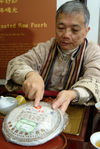
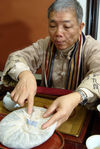
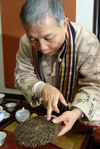
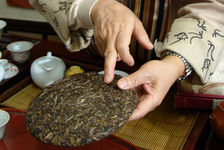
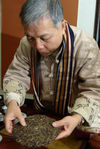
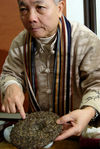
- 1. Vesper Chan detailing a 7811, first harvest
- 4. Vesper Chan detailing a 7811, first harvest
- 5. Vesper Chan detailing a 7811, first harvest
Now you can see on this cake (by showing us the surface of a 7811), tea in early spring must be very thin, with delicate buds. If all the buds are like this (showing us a larger bud) is a tea that comes from the late spring or autumn. And front and back must be the same. Then you know that it comes from a single series.
Yes. This is why informed consumers believe that the best quality is that of before 2003.
Yes, that's correct. I think the good must come from large trees (with a real trunk branches separated). Because the flavor of these trees is very natural, without pesticides and without fertilizers. Also artificial plantations (tai di), where the bushes are barely more than a meter, have roots that are barely a tenth the size of the plant. It's very different from the tall trees. Not only are they two or three times larger than the tai di, but their roots are half their size approx. They will go very deep into the soil and absorb nutrients and different types of minerals and purposes. And this type of substances of the earth is very good for your health and body.
Yes. It's also because I had the right of this ancient tree between 2002 and 2006. Each year, it would not produce more than 45 cakes. 40 to 45 pancakes. Very limited production. Of course, I asked why they could not produce more tea for me? And then they donnairent me a very nice explanation, but very true: The tree was too old, so the buds come once a year in early spring. And then the tree has enough energy to produce new young leaves.
A Lincang, we also found a wonderful taste, that of a tree 300 years old at the magnificent aroma, I will let you taste after. Such quality is rare, it is only the second time in 20 years of experience that I discovered a puerh (Pu Er tea) tea of this quality. The taste is not as rich in the mouth that tai di, because it is a large tree, but this tea produces a different feeling, which is much more elegant (laughs).
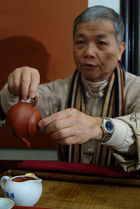
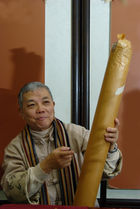
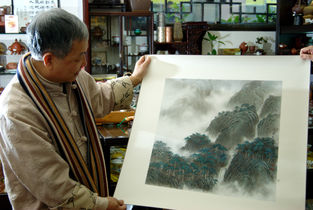
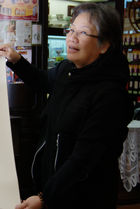
- 1. Vesper Chan that the outcome of its talks is offered a painting by one of his student who has followed for nearly 20 years
- 3. Vesper Chan that the outcome of its talks is offered a painting by one of his student who has followed since nearly 20 years
- 4. Vesper Chan from which to maintain this is offered a painting by one of his student who has followed for nearly 20 years

